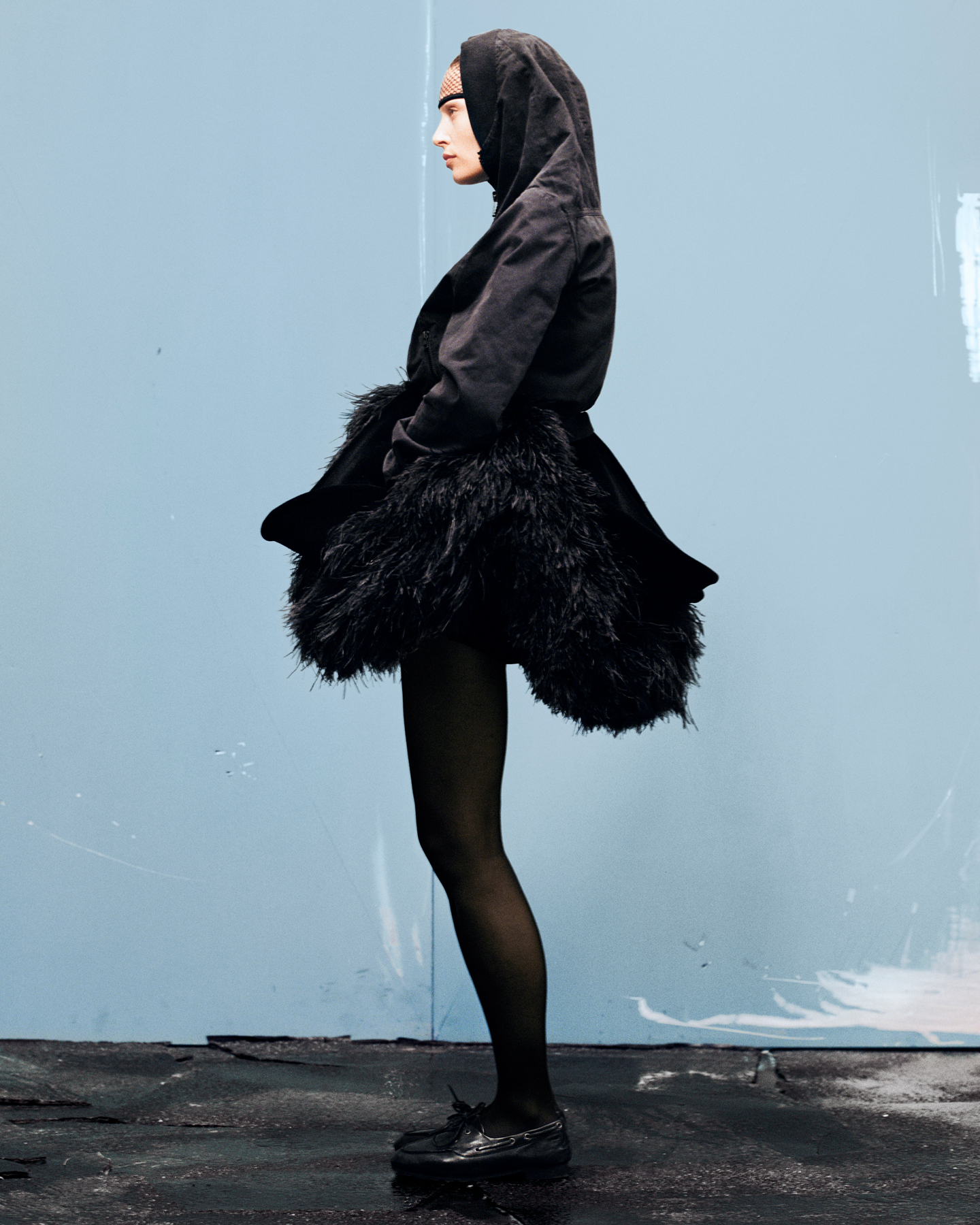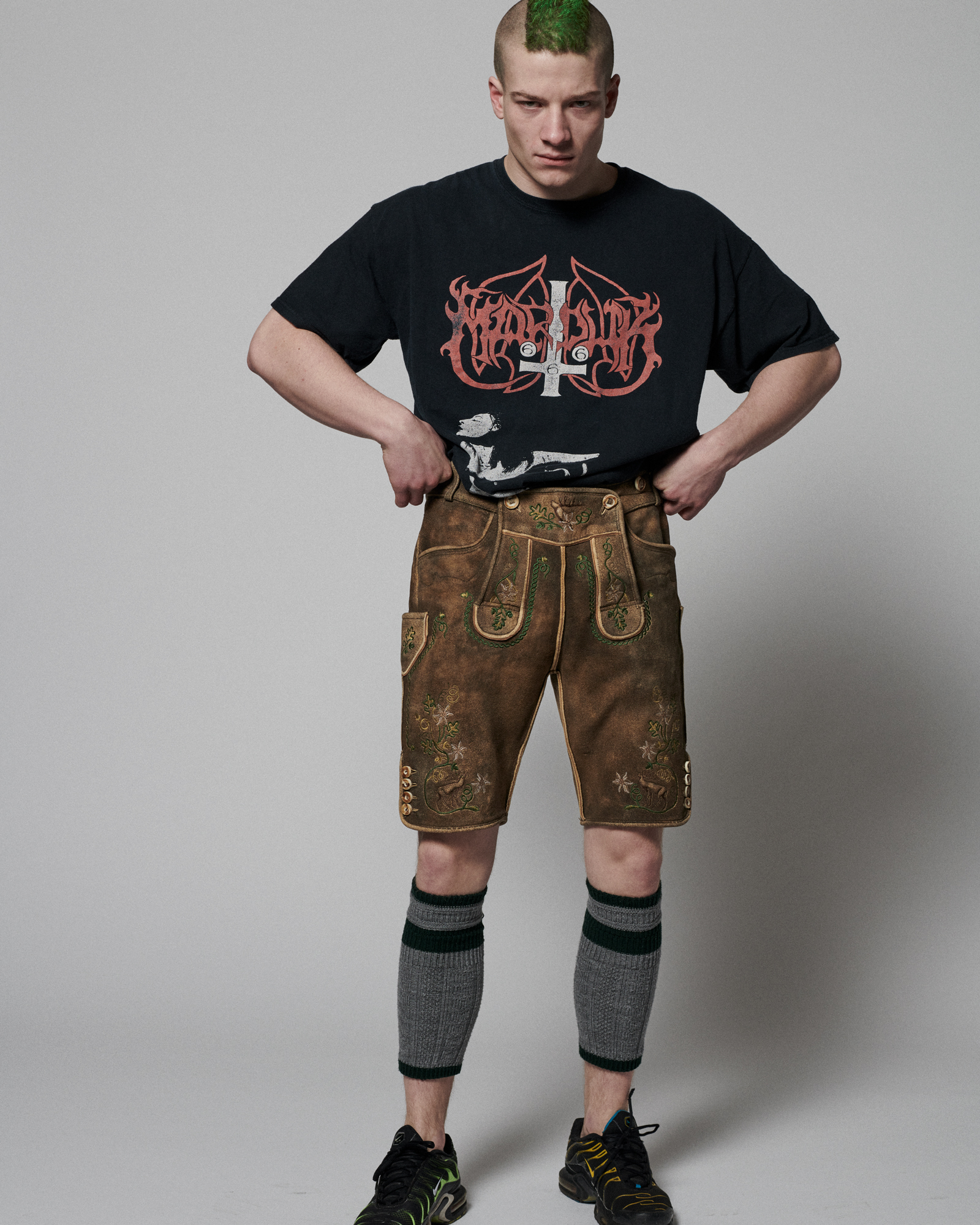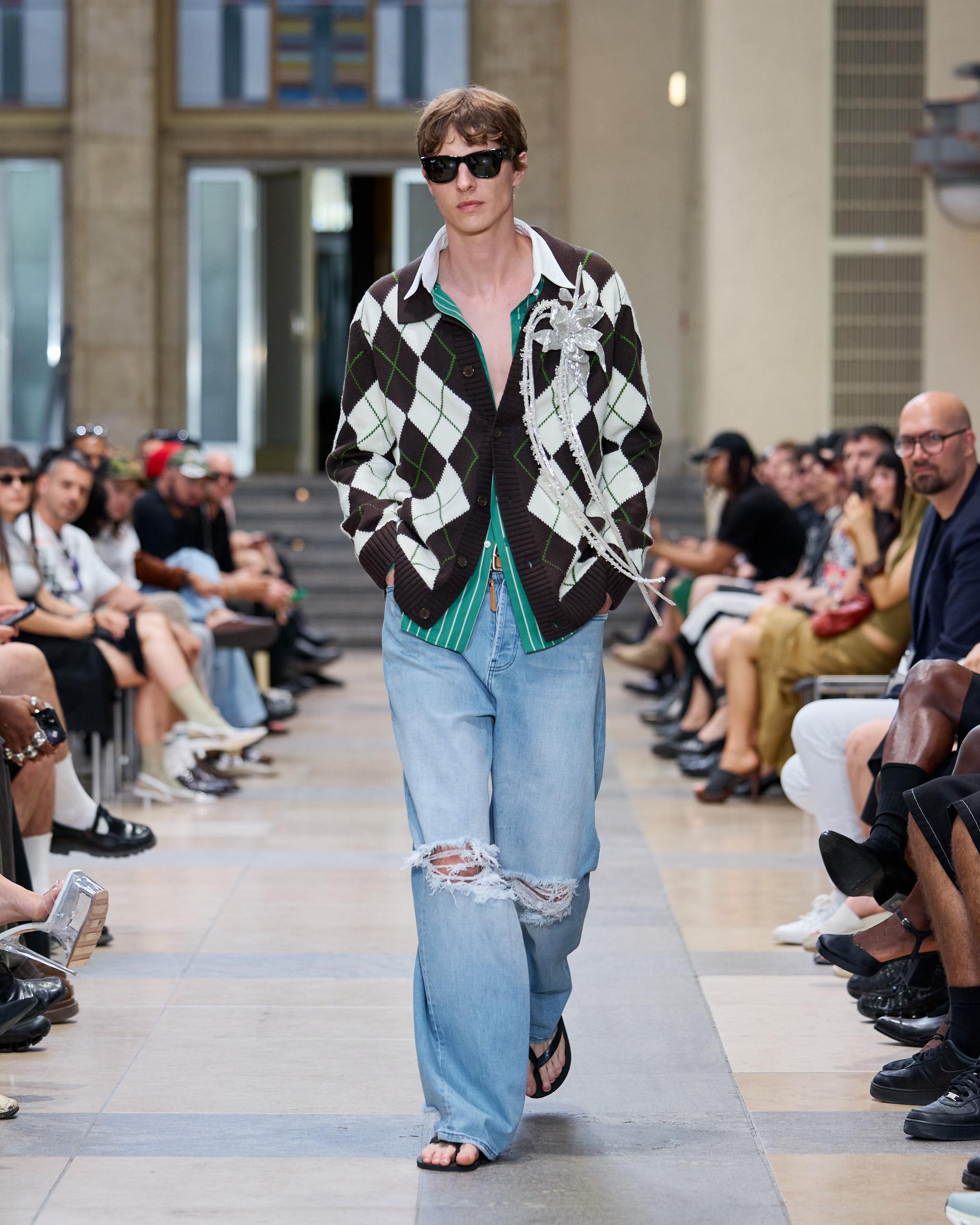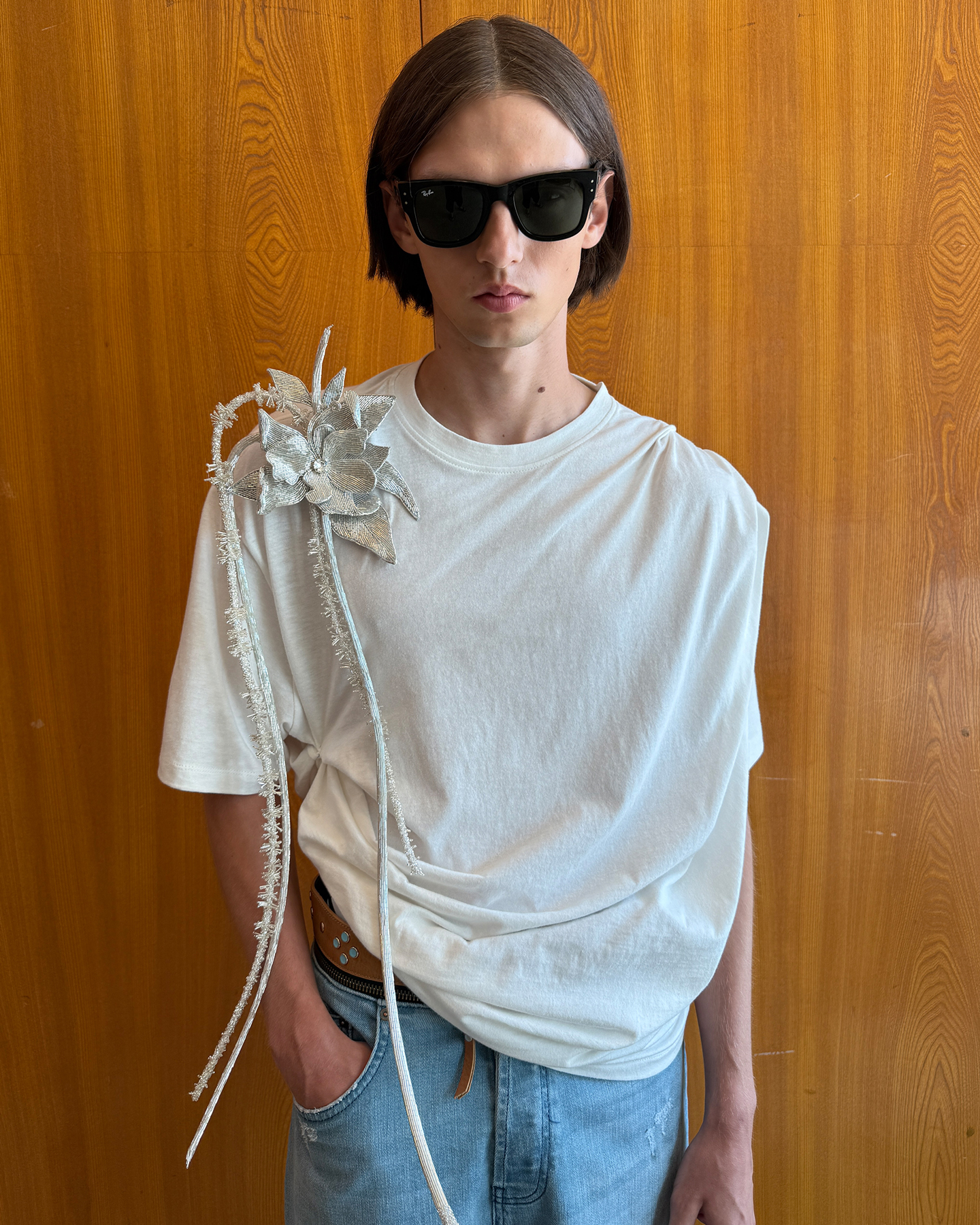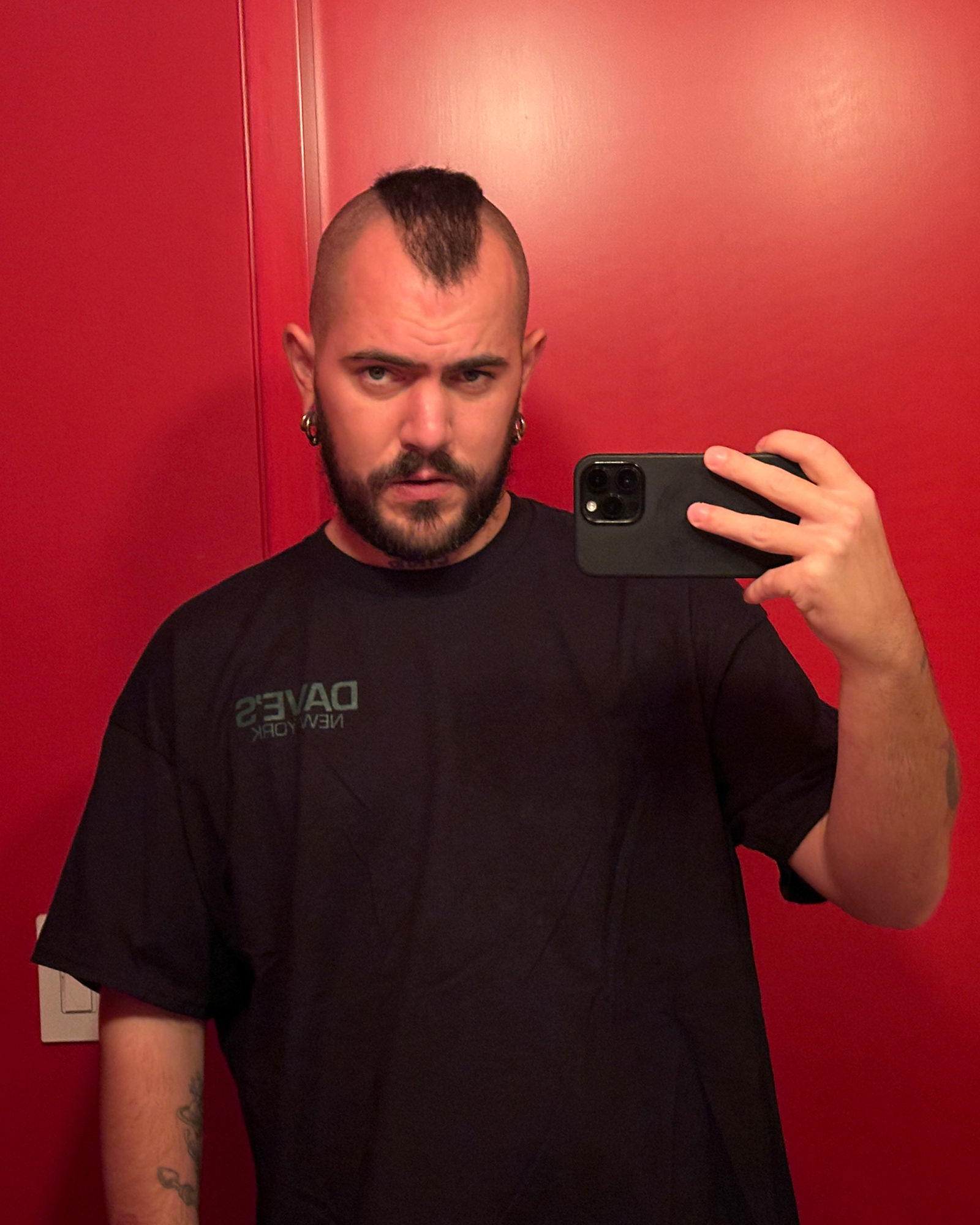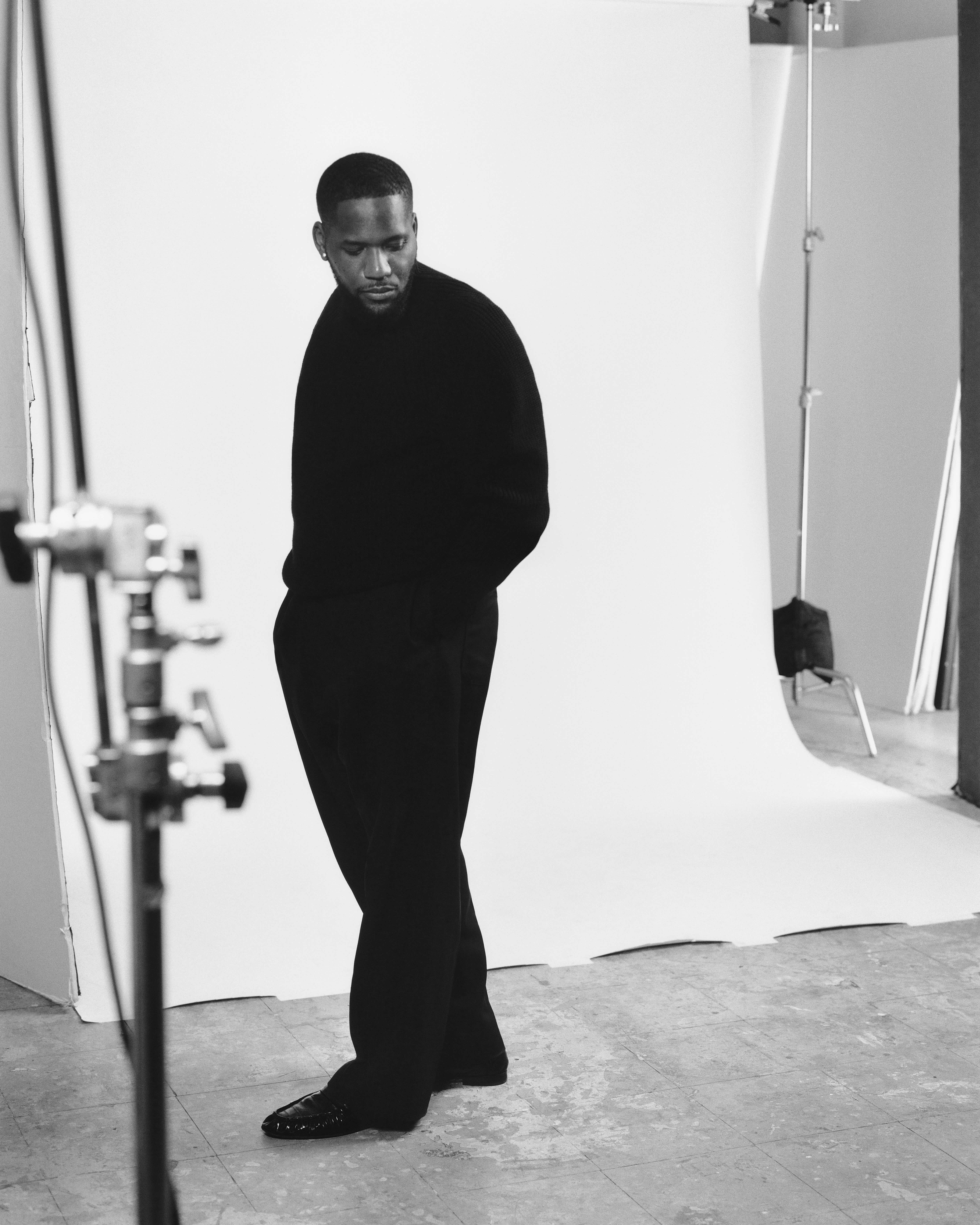Throughout fashion’s influential underground, Marc Goehring has become a paramount figure. As the current fashion director at EPOCH REVIEW, and successor to Mel Ottenberg’s tenure at 032c Magazine, he has well-earned his acclaim as a fashion polymath, with a sartorial footprint cemented through his work at independent publications. Carrying the title of a stylist, creative director, consultant, and existing as a mainstay in the lexicon of Berlin street style, the creative’s early years were spent in the Bavarian countryside, obsessing over Power Rangers light-up sneakers and dreaming about working at 032c as a teenager. There, his small-town experience was peaceful and not at all like the fast-paced cultural hub that is Berlin. Simultaneously, the visual and sartorial talent developed a strong desire for craftsmanship, particularly due to the traditional, Trachten clothing he remembered seeing around town. As a result, Goehring believes that breaking free from the limitations of small-town living while incorporating his love for tradition ultimately shaped his thinking. In working with brands like David Koma, Blumarine, and Louis Gabriel Nouchi, his stylistic approach remains intuitive yet dynamic, originating from a philosophy of harmony and balance to create a desired look. Models.com’s contributor Nia Shumake spoke with Goehring regarding his career trajectory, the state of Berlin’s cultural landscapes, his latest inspirations and print media.
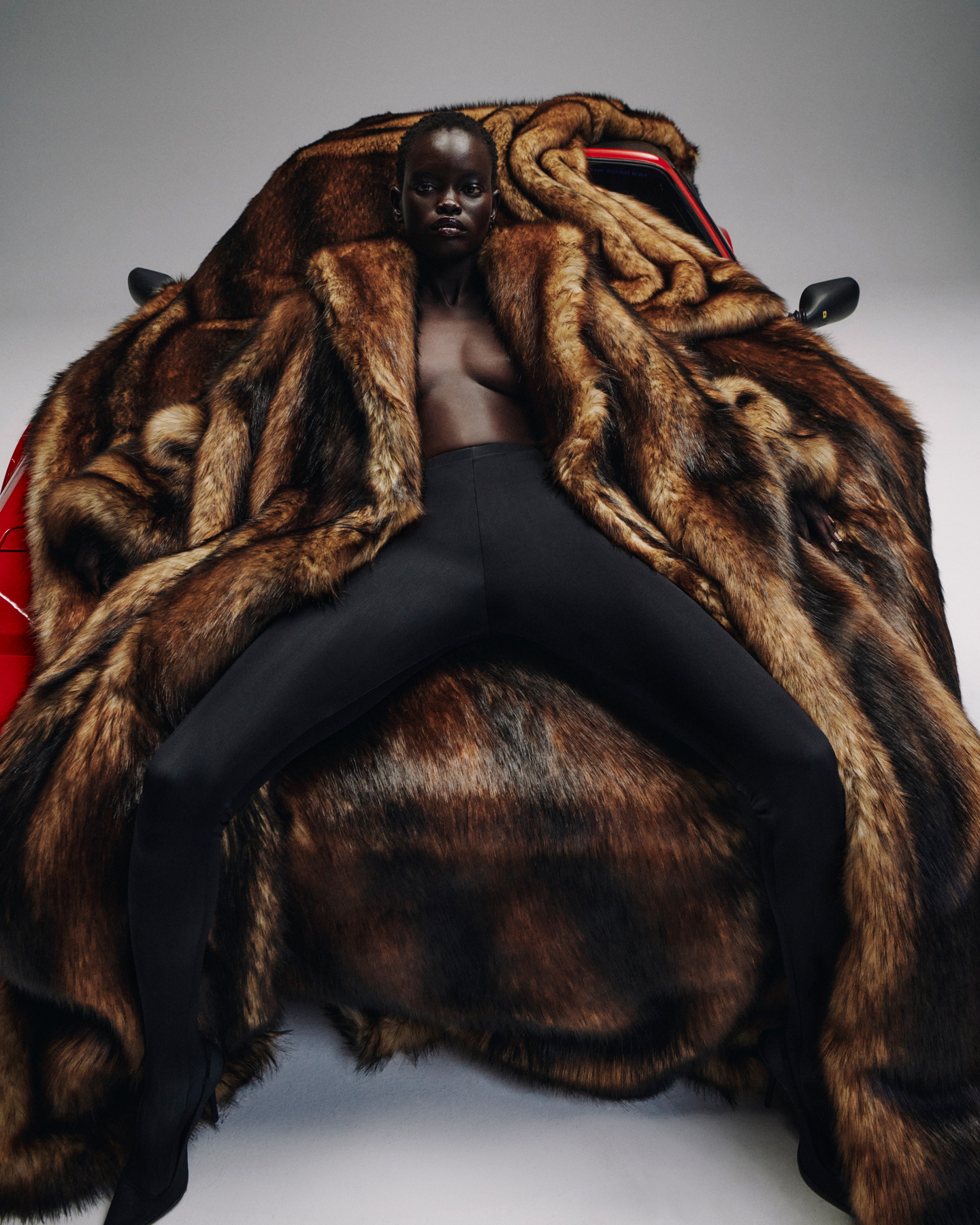
Athiec Geng by Zoe Natale Mannella for David Koma Pre-Fall 2025 Lookbook | Image courtesy of Marc Goehring Studios
What were your earliest memories of fashion?
One of my earliest and most vivid memories of fashion is an easy one – I was five years old and obsessed with a pair of Power Ranger sneakers that were, to me, the ultimate accessory. They didn’t just light up at the soles with every step, but they also had thick, bubbly Velcro patches on the sides that you could collect and swap. The patches featured different helmets, villains, and zords, all lighting up and even making sounds. It was pure joy. I felt like the happiest little boy on earth wearing them, and that feeling – of expressing yourself through something wearable, fun, and totally you – stuck with me ever since.
How did you get your start in the fashion industry?
Honestly, through pure luck and the way I dressed. That’s what got me noticed in the first place. When the opportunity came, I grabbed it with both hands and, excuse my language, worked my ass off. If you’re not born into this industry or didn’t grow up in one of the major fashion capitals, the only way in is to work and deliver. I showed up, stayed late, pushed myself, put my full heart in every shoot and project, and made sure every single job counted. If you’re passionate, hard-working and relentless, people notice, and from there, doors start to open.
Did you have a mentor or influence as a guiding point for your career trajectory?
Honestly? It’s probably easier to find the purple Milka cow where I’m from than to find a fashion mentor. I definitely didn’t have a traditional mentor. I had the trust of the right people at the right time. That trust, combined with my drive to deliver and prove myself, became the fuel for everything. In a way, my real mentor was my own mental strength and ambition; the deep need to break free from the small-town, countryside mindset I grew up in and that inner voice pushing me forward, telling me there’s more out there.
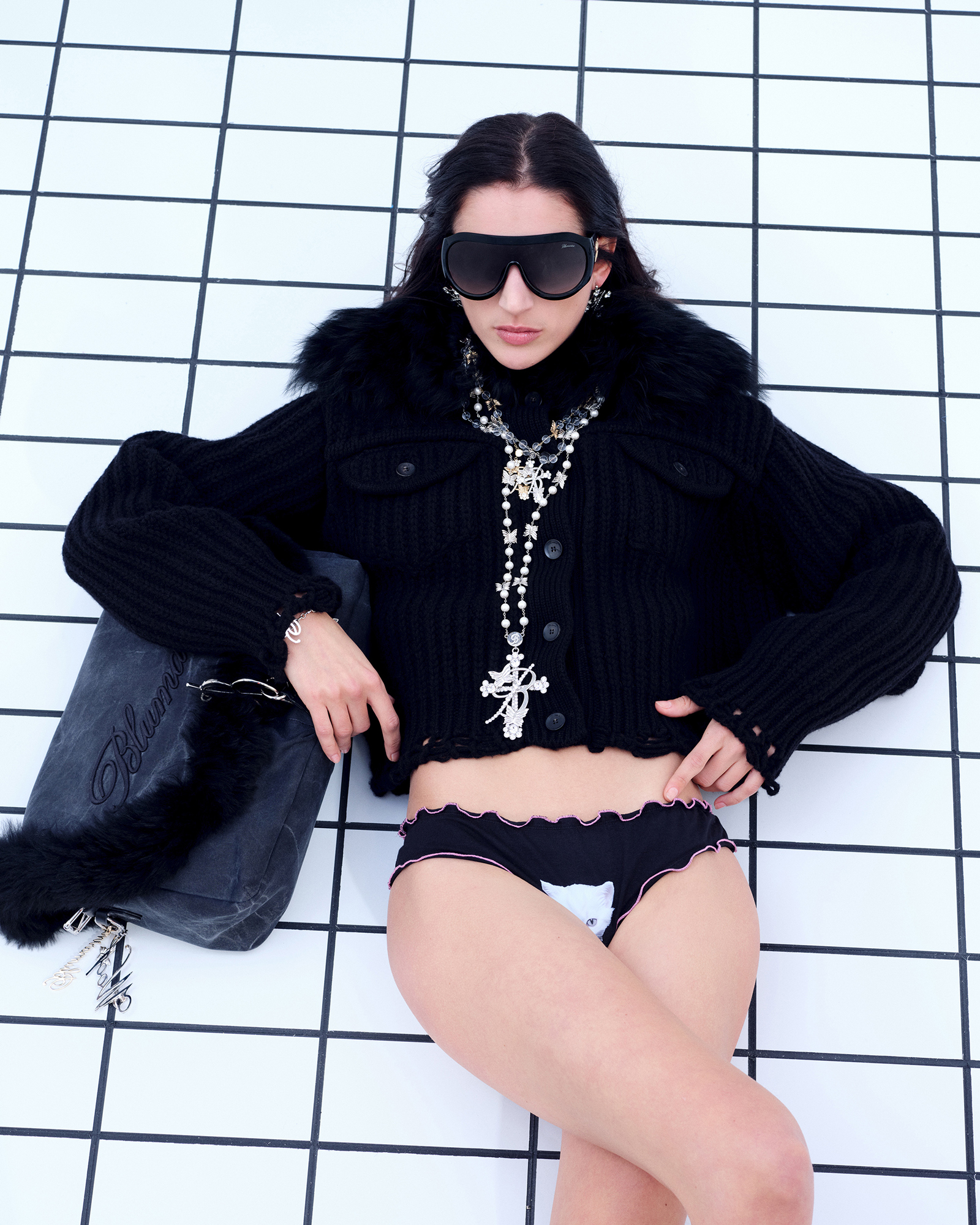
Rachel Marx by Liv Liberg for Blumarine Pre-Fall 2025 Lookbook | Image courtesy of Marc Goehring Studios
What was it like growing up in the Bavarian countryside and do you think that lifestyle contributed at all to your creative process?
It was peaceful and my lungs were definitely filled with some of the cleanest air on earth! Growing up there absolutely contributed to my drive. As I mentioned before, there was basically nothing around me in terms of fashion or the creative industry, so everything I’ve achieved came through hard work and pure determination. But if we talk more specifically about fashion, I’d say what really influenced me was the deep-rooted love for craftsmanship. Back home, there’s a strong culture around traditional Bavarian clothing, Trachten fashion, and I’ve been obsessed with it from early on. Really good Trachten pieces are almost like couture: intricate, symbolic, and made with serious skill and detail. So in a way, the combination of that beautiful tradition with a burning need to break free from the limitations of small-town life created this wide-open, fearless creative mindset in me. That contrast, of heritage and rebellion, has definitely shaped the way I think and create. To say it in one sentence: I was already the “crazy one” back home, so why not go wilder and more creative?
You were an editor at 032c and had dreams of working there since you were 15. At the time, why did 032c stand out to you and what were some of your most memorable moments at the publication?
At the time, 032c was, for me, the most radical, creative, and culturally sharp publication out there. It was super nerdy in the best way, mixing incredibly smart writing with bold, boundary-pushing fashion editorials, the best contributors, and intimate exhibitions and events in our office space. Basically, it felt like the coolest place on earth and it didn’t just report on culture, it shaped it. There were so many memorable moments, but what stands out most is the trust I received right from the beginning. I had just started as a fashion editor, and Joerg [Koch] fully believed in me, no micromanaging, no hesitation. For my first editorial, I was on my own: no team, three days of shooting, through the night, 42 models and talents…and I freaking rocked it. That story ended up being the cover of 032c, my very first editorial, becoming the cover of the magazine I had worshipped since I was 15. That moment felt like holding the holy grail. We were a small team back then, and it truly felt like a family — a family that just freaking rocked. Another core memory? The day I was told I’d become Fashion Director. I was in my early twenties, and suddenly I was leading the fashion department of what I still believe is the best publication out there. Total pinch-me moment. Of course, there were those funny, bittersweet moments, too, like seeing major fashion houses clearly referencing my editorials in their campaigns…you know, without hiring me. It’s classic fashion industry. I’m forever grateful for that time. It shaped me, pushed me, and proved to me what was possible.
What was the cultural landscape like in Berlin when you moved and what is it like now?
When I first moved to Berlin, it completely cracked open my brain in the best way. It felt like stepping into a whole new world—a big, chaotic, inspiring world. The energy, the people, the parties, the politics—it was all so raw and electrifying. It challenged everything I thought I knew and pushed me to explore who I really was creatively and personally. At the same time, and I would say this still applies today, Berlin has always had this underlying vibe of being a bit of a dark playground. There’s beauty in the freedom and chaos, but also a certain coldness. It’s a place where everyone’s too cool, and there’s very little support or community spirit. It can feel like you’re constantly swimming in your own lane, and collaboration doesn’t always come naturally here. So Berlin gave me a lot, it shaped me but it also taught me how to stand on my own and keep pushing.
Are you content with the current state of fashion in Berlin? What excites you at the moment and what else would you like to see?
To be honest, I’m not really content with the overall state of fashion in Berlin. It still feels like the city struggles to build a strong, supportive ecosystem for fashion, especially when compared to other creative hubs. That said, the one thing that does truly excite me right now is what Reference Studios is doing with their fashion week format, “INTERVENTIONS.” It’s bold, intelligent, and culturally relevant. They’ve managed to inject energy, creativity, and credibility back into the scene, finally creating a space that feels like it’s moving things forward.
What was it like transitioning from 032c to the EPOCH REVIEW? Could you speak to your experience working with fully independent publications?
There wasn’t a direct transition, actually. After leaving 032c, I took a much-needed break from the editorial world for almost three years, and to be honest, I needed that space. During that time, I started to realize how exhausted I’d become with the state of most publications. So many magazines today are terrified of real storytelling. Everyone just wants three safe photos in front of a wall with their top advertisers tagged, and whatever happens on the other eight pages, no one really cares. As long as they can post those three “full looks” on Instagram.
When you’re not tied to a publication, it becomes frustrating. You pitch strong, fully developed ideas, ready to shoot, and more often than not, no one’s really interested. Or it turns into this endless hustle. I mean, let’s be real — I was basically out there offering to create free, high-quality content, including advertiser coverage that helps pay their bills. A little more appreciation would be nice. But hey, no need to sound too whiny. We all know how the game works. It just started to feel…lame. Then came EPOCH, through my dear friend, Francesca Gavin, the editor-in-chief. Honestly, it brought that spark back. EPOCH gave me the same kind of nerdy, culture-obsessed, creatively fearless excitement I had back in the day. It’s a publication that’s not afraid. It’s smart, radical, and genuinely inspiring. A printed object you actually care about. So yeah, I’m back in editorial heaven. The fun is back. The family feeling is back, and I’m here for it.
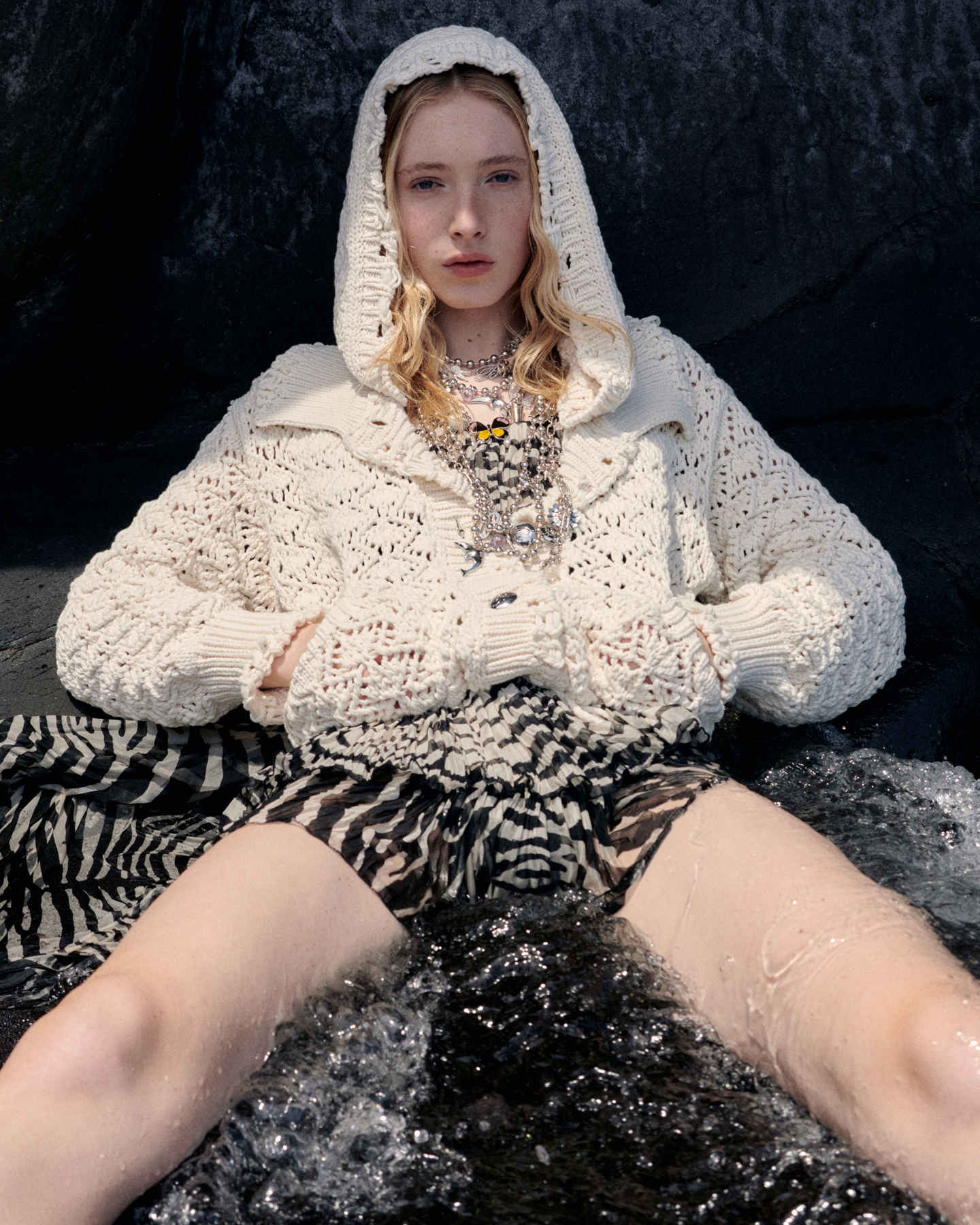
Summer Dirx by Zoe Natale Mannella for Blumarine Resort 2026 Lookbook | Image courtesy of Marc Goehring Studios
Can you tell us a bit more about EPOCH REVIEW?
EPOCH is an indexical, encyclopaedic, creative, expansive and very contemporary take on the wholeness of civilisation. The aim is to develop new narratives for the present by looking at connections with the past, drawing on archaeology, anthropology, visual art, fashion, technology, cultural studies, science, geology, music, language, and sociology. Our upcoming issue is truly unique: we’ve been given carte blanche to create an edition entirely devoted to – and in collaboration with [the city of] Pompeii. I mean this is what I am talking about – SICKKKKK!
How would you describe the print media industry in Berlin— and perhaps across Europe— do you find that consumers have an appetite for physical fashion media?
Let’s be real: physical fashion media is dead. Ask yourself — do you still buy all the magazines you used to buy back in the day? The answer is probably no. Most people don’t buy magazines anymore, and honestly, many just can’t afford to. Some publications are charging 75€ just for the issue, without shipping. That’s wild! That said, I still care. I still love the smell of paper, the weight of a beautifully printed object, and the magic of creating something physical and lasting. It’s a completely different experience from scrolling through a feed. Print fashion media today has become incredibly niche and honestly, that’s okay. I’d rather create something that reaches a smaller, dedicated audience who actually care, rather than produce something that ends up being flipped through at the hairdresser’s and tossed in the trash five minutes later. So yes, the appetite might be smaller, but for the right people, it’s still there and it’s real.
You mentioned that you style intuitively to W Magazine back in 2016 – has this changed at all and how so? If not, how have you managed to build a healthy relationship with your creative intuition?
In general, I’d say not much has changed in how I work; I still style very intuitively. But I now have an even better metaphor for it: Severance. You know the show? That’s exactly what it feels like sometimes. Being a stylist, especially when you’re juggling multiple projects, is like living inside your own version of Severance. The moment you walk through the door of a studio, office, board a plane, or arrive at a location, your brain completely recalibrates to that specific project. Most of the time, you’re seeing a collection in person for the very first time, and then you have maybe one or two days to build the entire visual identity of the season. So intuition isn’t just part of the process, it’s the only way to survive. And then? The next day, you walk through another door, and it’s a completely different world, a whole new collection, and a fresh chance to have fun and create something unexpected. That mental reset, that fast-paced shifting, it keeps me sharp, present, and deeply connected to my creative instincts. So, intuition is still the core of it all. I’ve just learned to trust it even more.
You’ve mentioned in the past that you never want to overdress—how do you strike the best balance?
Well, that’s obviously a very subjective point of view — my own, of course. Honestly, I’d say most of the time I’m probably highly underdressed by industry standards. I just dress in a way that feels natural and comfortable to me: a solid pair of shorts, a great vintage shirt, and some good sunglasses, that’s my uniform. So the “balance,” for me, is simple: the people who get it, get it —thats actually a unique piece Prada short, Jacques Marie Mage sunglasses, a Miu Miu jacket and a damn good vintage t-shirt — and the rest probably just think I’m some random dude on the street on his lunch break from the nearby construction site. And I’m totally fine with that.
“Labels are for press releases, style should be free of any labels.”
You’re often photographed showcasing your street style and I’d love to know what you consider the key to blending luxury fashion with street wear?
Honestly, I don’t think there is a key. As soon as you wear something outside, it becomes streetwear, so in that sense, everything can be streetwear. To be really honest, I actually hate the term “streetwear.” It feels vague, overused, and weirdly discriminatory toward fashion itself. Like, if I wear a Chanel jacket with shorts and a pair of cool sneakers, it suddenly gets labeled as “streetwear look.” But if I wear the same jacket and shorts with moccasins instead, suddenly it’s not? That makes no sense to me. At the end of the day, it’s just clothing. Wear it. Have fun with it. Use it. Feel it. Walk in the streets with it. That’s the whole point of fashion. Labels are for press releases, style should be free of any labels.
You’ve collaborated with David Koma for his recent menswear show in Berlin—how was the experience and would you say that your involvement with the brand is different from your work with other clients?
I wouldn’t necessarily say my involvement with David is different, but it’s definitely deeper, simply because of our long-standing collaboration. We’ve built a strong creative relationship over time, and we talk a lot, which I really value. That open dialogue makes the process fluid, honest, and creatively rich. That said, I always involve myself fully in every project I take on. Whether it’s David or another client, I care deeply about every aspect, not just the fashion. I want to make each job the best it can be, from the big picture down to the smallest detail, because I want to be proud of the work. So while the connection might feel more personal with someone like David, the level of dedication is the same across the board.
Who have been your favorite muses and collaborators?
I’d actually like to answer this a little differently — for me, it’s never been about one specific muse or named collaborator. The best kind of collaboration happens when the entire team on set knows each other, trusts each other, and the energy is just flowing. That’s when the magic happens. Working with friends, or people who feel like friends, always brings out something special. It creates a safe space for experimentation, for pushing boundaries, and for having fun, and the result always reflects that. That said, my absolute favorite collaborators are my team. They’re the ones who are in the trenches with me, bringing the vision to life, staying up late, solving problems, laughing through chaos. I couldn’t do it without them. They’re my creative family.
What mediums have inspired you lately? As a creative, how are you sourcing inspiration?
Anime. Anime. Anime. Period!
What do you think is the key to building out an ideal editorial project? What is essential to dynamic collaboration?
Two things:
A) Multiple sample sets of each collection, available worldwide LOL
B) You know your team – good vibes
